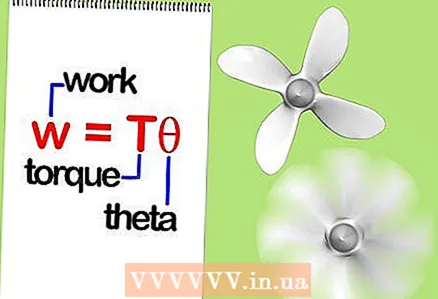Author:
Virginia Floyd
Date Of Creation:
12 August 2021
Update Date:
22 June 2024

Content
How to calculate horsepower or watts, what they characterize and why they matter.
Steps
 1 The basics. The word "power" is defined as work done in a specified time. Work, in turn, is a historical term that characterizes the effectiveness of an applied force (to move the body or to overcome other obstacles or resistance) over a certain distance.
1 The basics. The word "power" is defined as work done in a specified time. Work, in turn, is a historical term that characterizes the effectiveness of an applied force (to move the body or to overcome other obstacles or resistance) over a certain distance. - The important thing here is that for "work" the force must act at a certain distance. For example, if the propeller moves the boat through the water with a force of 300 N at a distance of 80 m, then the work is equal to the force x distance = 300 X 80 = 24000 J (N * m), that is, we can say that the propeller did 24000 J of work.
- Consider the time it took to move the boat a certain distance. Suppose the ship is moving at a speed of 20 m / s. It would take 80/20 = 4 seconds to travel 80 meters. So, the boat's propeller did 24000 J of work in 4 seconds, so the power is: 24000/4 = 6000 W (J / s).
- Historical reference. Before internal combustion engines and steam power, which propelled the very first trains and ships (the first propeller was installed on the HMS Britain, which first went to sea in 1846; it had one six-blade propeller that looked like a windmill) , a huge number of different tasks were performed by horses. Therefore, people calculated the amount of work that one horse can do in a given time. After averaging the values from a number of trials, they settled at 550 lb-ft per second as the standard value for work done by a healthy horse. Then this value became known as "horsepower".
- In Russia, horsepower refers to metric horsepower, which is approximately 735.5 watts.
- Another commonly used unit of power is "Watt" (SI International System of Units). If a force of one Newton moves the body a distance of one meter, then the work is equal to one Joule, and if this work takes one second, then the power is equal to one Watt. Therefore, a watt is equal to one joule per second.
 2 Consider today's industry needs. In the overwhelming majority of cases in industry, we are dealing with rotating mechanisms, and not rectilinear motion. So we need to know how to calculate the power of electric motors, steam engines, turbines, diesels, etc., and therefore we need to consider the torque, or more correctly the moment of force.
2 Consider today's industry needs. In the overwhelming majority of cases in industry, we are dealing with rotating mechanisms, and not rectilinear motion. So we need to know how to calculate the power of electric motors, steam engines, turbines, diesels, etc., and therefore we need to consider the torque, or more correctly the moment of force. - The moment of force characterizes the force tending to rotate or twist something, that is, to impart a rotational motion to the body about a certain axis. If you twist a 50 cm (0.5 m) handle with a force of 200 N, then the moment of force is 0.5 x 200 = 100 N * m.
- Don't get confused. To calculate the work done in straight-line movement, you multiply the force by the movement. And here you are multiplying the force by the displacement, but in this case the displacement is equal to the "lever", that is, the distance from the axis to the point of application of the force.
- Work and moment of power are different concepts. As long as the moment of force does not rotate, no work is done and no power is consumed.
 3 Measure the work in rotary motion. Suppose a 50 cm long lever is rigidly attached to the axis of rotation, you apply a force of 200 N to it, while the lever rotates 20 cm around the circumference. Work in this case is equal to the product of force and displacement, that is, 0.2 x 200 = 40 N * m. Suppose you are simultaneously multiplying and dividing this figure by 0.5 m - the length of the arm. Obviously this won't change the result, so you can write:
3 Measure the work in rotary motion. Suppose a 50 cm long lever is rigidly attached to the axis of rotation, you apply a force of 200 N to it, while the lever rotates 20 cm around the circumference. Work in this case is equal to the product of force and displacement, that is, 0.2 x 200 = 40 N * m. Suppose you are simultaneously multiplying and dividing this figure by 0.5 m - the length of the arm. Obviously this won't change the result, so you can write: - Work = 0.5 • 200 X 0.2 / 0.5 and once again get the answer: 40 N * m. But what does the product 0.5 * 200 mean? This is the moment of power.
- What is 0.2 / 0.5? 20 cm of circumferential travel divided by the length of the arm (essentially the radius of the circle) gives you the amount of rotation in radians.A radian is defined as the angle between two radii of a circle in a situation where the length of the arc between the two radii is equal to the radius of the circle. 1 rad = 57 degrees (approximately).
- Thus, the work done by the moment of force during rotational displacement (theta, in radians) is equal to the product of the torque (M) by the amount of rotational displacement (in radians):
- Work = M * theta (in radians)
 4 Please note that the power is calculated over a certain time, therefore:
4 Please note that the power is calculated over a certain time, therefore:- Power = moment of force * (angle / time)
- angle / time is angular velocity (in rad / s)
- In physics, angular velocity is measured in radians per second, but this value for an aircraft or ship engine is always given in revolutions per minute and therefore we will have to convert these values.
- One revolution per minute (rpm) = 60 revolutions per second (rps) and one revolution per second = 2 * PI radians per second
- If M is the moment of force (torque), n is the number of revolutions per minute, then the power in watts is equal to:
- Power = M * (2 * PI / 60) * n
- In order to get this value in horsepower, you need to divide it by 735.5.



